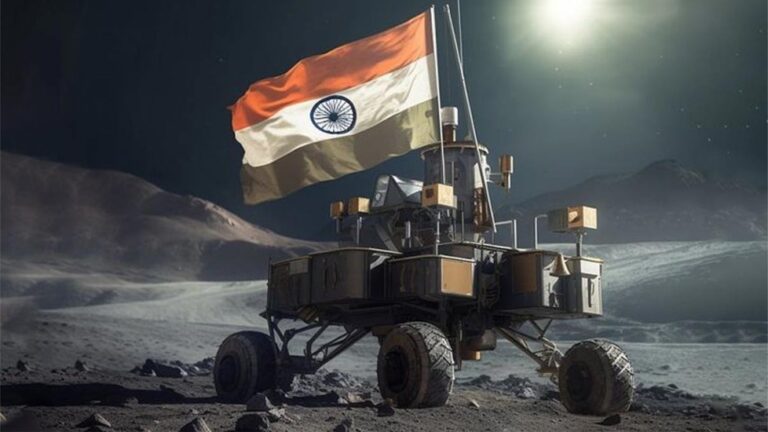![]()
In a momentous accomplishment, India has once again etched its name in the annals of space exploration. While India had previously secured the fourth position for a soft landing on the Moon’s North Pole, it has now achieved an unprecedented feat by becoming the first country in the world to accomplish a successful soft landing on the Moon’s challenging South Pole. This remarkable achievement marks a significant milestone in humanity’s quest for lunar exploration.
Previously, India had joined an elite group of nations—comprising the US, the former Soviet Union, and China—who had achieved soft landings on the Moon. However, this latest triumph differentiates India by venturing into uncharted territory and conquering the lunar South Pole, a remarkable feat that no other nation has dared to accomplish.
Amidst nationwide celebrations, Prime Minister Narendra Modi proudly declared, “India is now on the Moon,” emphasizing the unparalleled accomplishment. Mr. Modi shared his joy even while attending the Brics summit in South Africa.
The Vikram lander from the Chandrayaan-3 mission executed a precise touchdown as planned at 18:04 local time (12:34 GMT). This achievement holds heightened significance considering the recent setback Russia faced when its Luna-25 spacecraft lost control and crashed into the Moon.
Chandrayaan-3’s mission is to explore the challenging lunar south pole region, characterized by rugged terrain, craters, and boulders. A previous attempt by India’s Chandrayaan-2 mission in 2019 faced challenges leading to the destruction of the lander and rover, though the orbiter persevered.
The meticulous execution of Chandrayaan-3’s descent, named Vikram after ISRO founder Vikram Sarabhai, was accompanied by nail-biting moments as it carried the 26kg rover named Pragyaan (Sanskrit for wisdom). Gradually reducing its speed from 1.68km per second to nearly zero, Vikram achieved a gentle, successful landing.
In the coming hours, once the lunar dust settles, the six-wheeled rover will disembark from Vikram’s hold. It will explore the Moon’s surface, capturing vital data and images to transmit back to Earth. This mission holds immense promise, with a key objective being the search for water-based ice, crucial for future lunar habitation and as a propellant resource for distant space missions.
Chandrayaan-3 carries five scientific instruments to study the Moon’s surface properties, atmospheric conditions, and tectonic activities beneath. The rover proudly bears India’s flag, along with ISRO’s logo and emblem embossed on its wheels, leaving imprints on the lunar soil as it explores.
Chandrayaan-3 stands as India’s third lunar mission, following the success of Chandrayaan-1 in 2008, which unveiled the presence of water molecules on the lunar surface and affirmed the Moon’s daytime atmosphere. Even though Chandrayaan-2’s lander did not achieve a soft landing, its orbiter continues to transmit valuable data.
The achievement has ignited jubilation across India, with educational institutions, offices, and public spaces joining the live telecast of the Chandrayaan-3’s historic descent. Citizens, especially students, were glued to screens as they witnessed this remarkable feat. The involvement of schools, colleges, and universities in actively publicizing and streaming the event exemplifies the nationwide enthusiasm.
The successful mission has not only instilled confidence in India’s space scientists but has also ignited discussions about the Moon’s potential as a gateway to deep space exploration. As other countries also embark on lunar missions, India’s Chandrayaan-3 stands out as a testament to human ingenuity and determination, propelling India into an exclusive club of lunar explorers.
Indeed, India’s tryst with the Moon has created ripples of happiness across the nation. From educational institutions to religious places, people from all walks of life joined in collective celebration, reveling in the joy of this historic achievement.
The Chandrayaan-3 mission, valued at Rs 600 crore, was launched on July 14 via Launch Vehicle Mark-III (LVM-3) rocket. With its lander and six-wheeled rover boasting a total mass of 1,752 kg, the mission is set to operate for an Earth-equivalent of about 14 days on the Moon’s surface. This success bolsters India’s confidence to undertake even more ambitious future space missions.
#Chandrayaan3 #Chandrayaan3Success #ISROmissions #isrochandrayaan3mission #MoonLanding #India #VikramLander
References:







